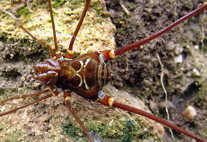Abstract
A new genus and five new species of digeneans are reported from fishes at hydrothermal vent sites in the South East Pacific Rise region. Biospeedotrema n. gen. (Opecoelidae: Stenakrinae) is distinguished from other stenakrines by the more or less symmetrical testicular configuration, with the uterus passing between the testes, sometimes distinctly into the post-testicular region. Biospeedotrema jolliveti n. gen., n. sp. from Ventichthys biospeedoi (Ophidiidae) is distinguished by the vitelline fields which extend only slightly into the post-testicular region, the intestinal bifurcation is dorsal to the ventral sucker, the genital pore is slightly dextrally submedian or median, the cirrus sac is short and the caeca are broad and overlap the testes, usually reaching into the post-testicular region. Biospeedotrema parajolliveti n. sp. from Thermichthys hollisi differs from Biospeedotrema jolliveti in being squat, always just wider than long, the tegument is wrinkled, the testes are lobate, and the caeca only just reach to the testes. Biospeedotrema biospeedoi n. sp. from T. hollisi differs from its congeners in its body-shape, uterine extent posterior to the testes and the small vitellarium. Caudotestis ventichthysi n. sp. (Opecoelidae: Stenakrinae) from V. biospeedoi is distinguished from its five congeners in various combinations of caecal length, cirrus sac length, internal seminal vesicle shape, vitelline extent and distribution, forebody length and egg-size. Buticulotrema thermichthysi n. sp. (Opecoelidae: Opecoelininae) from T. hollisi (Bythitidae) is distinguished from its only congener by its very long, very strongly muscular oesophagus, bifurcating dorsally to the posterior part of the ventral sucker, the long, narrow pars prostatica and distal male duct and the sinistral genital pore at the level of the pharynx. The phylogenetic position for three of these species, Buticulotrema thermichthysi, Biospeedotrema jolliveti and Biospeedotrema biospeedoi, is assessed based on ssrDNA and lsrDNA sequences, which verify the position of these species in the Opecoelidae.

